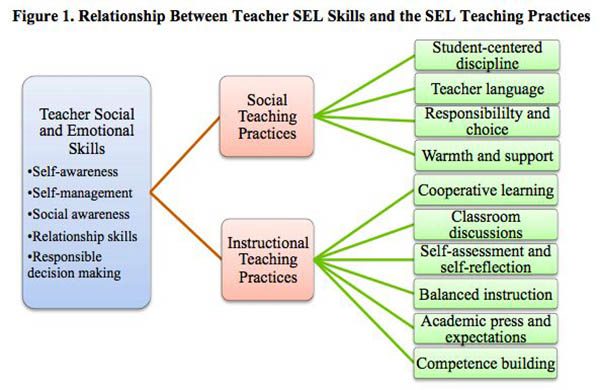
Self-Assessing Social and Emotional Instruction and Competencies
Educators reflect upon their SEL teaching practices and their own social-emotional competencies for implementing those teaching practices.

Educators reflect upon their SEL teaching practices and their own social-emotional competencies for implementing those teaching practices.
School staff will:

This practice is part of Self-Assessing Social and Emotional Instruction and Competencies: A Tool for Teachers by Nick Yoder, Ph.D., for the Center on Great Teachers and Leaders for the American Institutes for Research, 2014. Click here for more information.
Was this assessment helpful? If so, in what ways? Did it give you a deeper insight or understanding of how SEL can be woven into teaching practices?
The 10 research-based teaching practices that promote social-emotional competencies cross-reference well with three popular professional teaching frameworks (CLASS, Danielson’s Framework for Teaching, and the Marzano Observational Protocol), illustrating how the instructional practices that are already used to evaluate teachers are similar to the instructional strategies used to promote social, emotional, and cognitive development.
Thus, if teachers are enacting good pedagogy based on the strategies identified in their teacher evaluations, they are also doing things that promote student social-emotional competencies.
In addition, ongoing support and training is key to successfully implementing SEL into schools. Indeed, researchers have found that SEL program implementation is more successful when all stakeholders in a school are committed to SEL as part of their professional development.
Many of these 10 teaching practices are already being implemented by classroom teachers and are included in several common professional teaching frameworks in teacher evaluation systems. Yet, even though these teaching practices are commonly used, they are rarely thought of in terms of SEL.
For example, a teacher may implement cooperative learning groups but may not focus on ensuring that students are working together using positive relationship skills. Through these 10 practices, teachers can connect what they are already doing to also promote student social-emotional competencies.

Are you ready to build a kinder, happier school where everyone belongs? Join Greater Good Educators! Explore the science of well-being in a supportive community of educators from around the world. Registration is now open for the 2025-2026 school year!
Comments